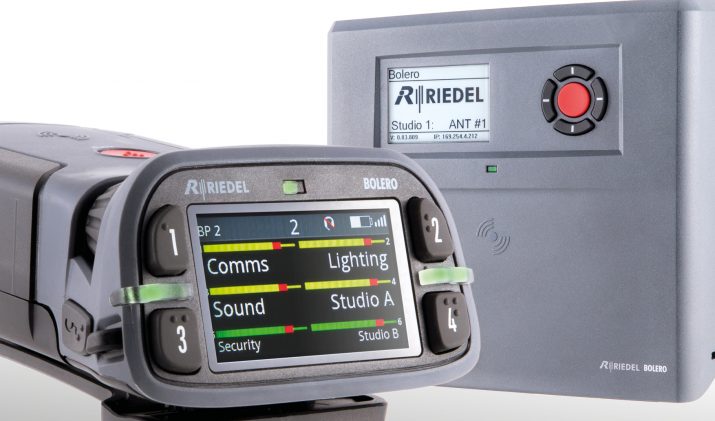InfoComm 2018: Riedel Communications To Unveil Latest Real-Time Signal Distribution, Networking Solutions
Story Highlights
At InfoComm 2018, Riedel Communications (Booth C1334) will unveil its latest innovations in real-time signal distribution and networking solutions for broadcast and live performance. Riedel’s product line reflects the company’s continued support of standards and interoperability, ongoing development and expansion of software app-based solutions, and concept of decentralized signal routing.
New: Bolero Standalone Wireless Intercom System
 Riedel will showcase its all-new Bolero Standalone Application, a license-enabled upgrade for the company’s category-defining Bolero wireless intercom system that delivers several performance enhancements along with standalone capabilities. With the Bolero Standalone Application, antennas are daisy-chained to each other in a line or a redundant ring via a low-latency, synchronized TDM network.
Riedel will showcase its all-new Bolero Standalone Application, a license-enabled upgrade for the company’s category-defining Bolero wireless intercom system that delivers several performance enhancements along with standalone capabilities. With the Bolero Standalone Application, antennas are daisy-chained to each other in a line or a redundant ring via a low-latency, synchronized TDM network.
Bolero is truly plug-and-play, with no IP configuration needed. A new external power supply can power up to five antennas, so power and data redundancies are easily achieved. A new, single-RU, half-width external interface box, with six analog 4-wires and three GPIOs, can be directly connected to any antenna and then patched into an existing intercom system. The system is easily configured via a web GUI internal to the antennas. Other new capabilities provided by the Bolero update include individual rotary programming, Bluetooth headset support, and a new beltpack QuickMute feature that allows users to set the volume of all channels to zero easily.
“At this year’s InfoComm, attendees will experience how Riedel is continuing to push the edge of innovation in real-time signal distribution and networking,” says Joyce Bente, President and CEO of Riedel North America. “The new standalone version of our Bolero is a repack-safe wireless intercom solution for rental houses, clients with smaller requirements, and clients who are already invested in other intercom solutions. And our new 1200 series SmartPanel represents a quantum leap forward in workflow flexibility, power, and connectivity.”
NEW: SmartPanel 1200 Series
Also at InfoComm 2018, Riedel will display its new 1200 series SmartPanel (RSP-1232HL). The RSP-1232HL panel features multiple full-color multitouch displays, 32 innovative hybrid-lever keys, the ability to leverage apps for multifunctionality, and the ability to adapt easily to the various workflows in use today. As the latest of the company’s highly popular SmartPanel app-driven user interfaces, the RSP-1232HL is poised to allow users to work the way they always have while opening up entirely new possibilities.
Each of the RSP-1232HL’s 32 lever keys features an integrated rotary encoder that provides control over parameters in the same location as the key. Users are able to choose custom colors for either the key labels or the LED rings that are positioned around each key. In addition, the RSP-1232HL supports AES67 audio through two fiber SFPs and two RJ45 connections that offer a variety of daisy-chaining and redundancy options and deliver extraordinary cabling flexibility.
MediorNet MicroN IP App
Riedel’s MicroN IP App creates a seamless bridge between the company’s award-winning MediorNet real-time signal routing network and IP networks. The MicroN IP App supports SMPTE ST 2110/AES67-compliant video and audio as well as baseband video (SDI) and audio (MADI). In combination with all the built-in glue features — including audio embedding/de-embedding, frame sync, sample rate conversion, audio/video delay, signal routing, and on-screen display — the MicroN IP App turns the device into a universal tool for all IP-interfacing needs. At the same time, the device can be fully networked with all existing MediorNet products. MicroN IP applications range from a stand-alone SDI-to-IP converter to a fully networked system with numerous different IP gateways and baseband inputs and outputs.
The MicroN IP App includes support for up to four MediorNet high-speed links, up to four SMPTE 2110-20 inputs and outputs, four baseband 3G-SDI signals, and eight 3G-SDI outputs. Four of these outputs are dedicated to monitoring the SMPTE ST 2110-20 streams. Also supported are up to 128 channels of AES67 audio, two optical MADI ports, and sync I/O.
